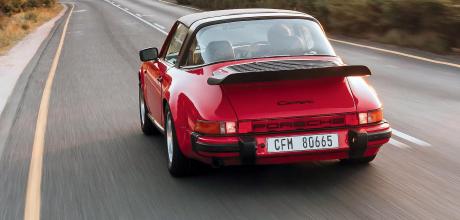1984 Porsche 911 Targa 3.2
Celebrating 50 years of impact-bumper 911s, we take a 3.2 Targa for a morning drive to the mountains in South Africa’s Western Cape province. Can it offer the perfect air-cooled experience?
Written by Wilhelm Lutjeharms
Photography by Peet Mocke
3.2 Targa breakfast run
Wilhelm Lutjeharms watches the sun rise through the windscreen of a glorious, G-bodied Targa
Enthusiasts of different ages will have contrasting views on the design of the impact bumper 911 series. I was born in 1981, and only later discovered that these bumpers came about as a direct result of new crash safety legislation in the USA. Then I realised why some enthusiasts (especially those building 911 outlaws) quickly remove these bumpers as they put together their personalised build – it gives any 911 a much smoother look. However, if you’re used to these bumpers then you quickly see past them.
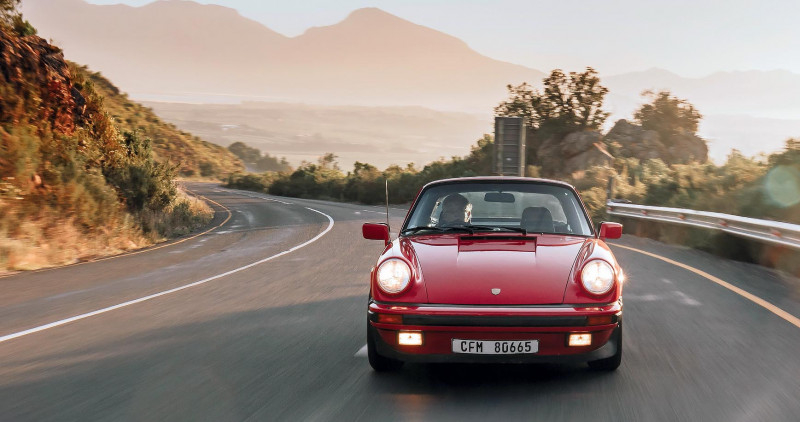
This year we celebrate no less than 50 years of this era of 911, which enjoyed the longest production, from late 1973 through to 1989. It’s the 911s from the final years of the impact bumper cars (think 1986 to 1989) that connoisseurs usually seek out. These cars were fitted with the G50 gearbox, perceived to be the drivetrain to have. They’re relatively few and far between, and they also trade at a healthy margin above the earlier, 915-transmission equipped cars.
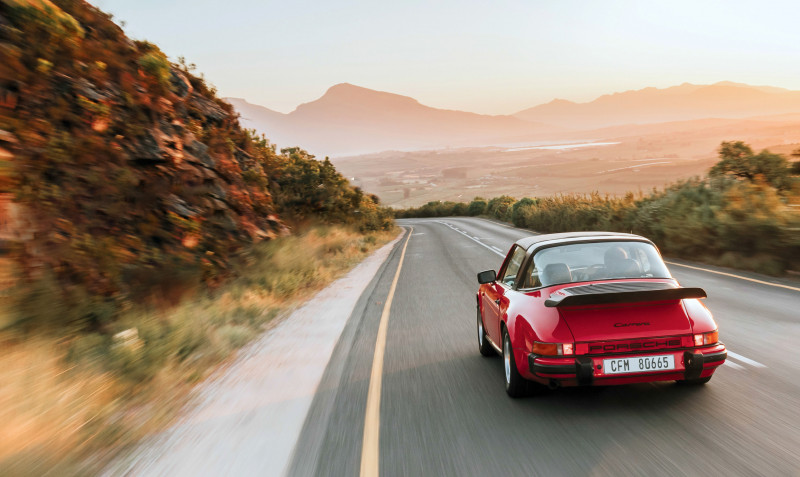
By the end of G-series production, the Carrera was offered in three different body styles: Coupe, Cabriolet and Targa. For many years the Targa was viewed as an awkward halfway house between Coupe and Cabriolet: some enthusiasts prefer to have a tin top over their heads, while others like the al fresco enjoyment a Cabriolet brings to the driving experience. But isn’t this precisely where the Targa fits in, offering the best of both worlds and not being a compromise as a result?
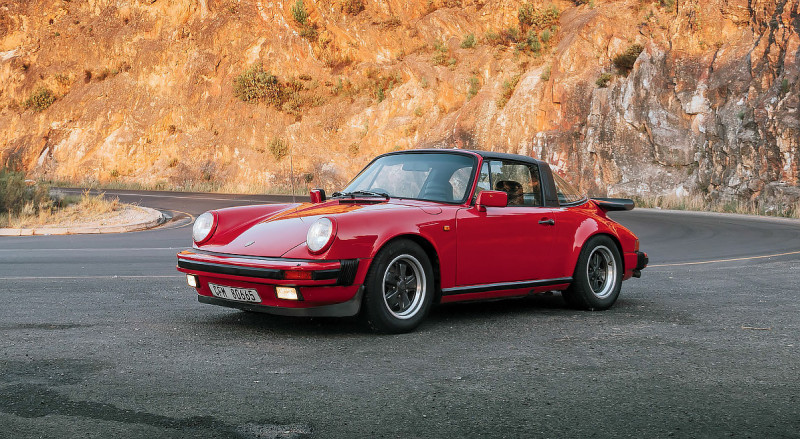
The owner of the car in Peet’s photographs has had just over 10 classic, air-cooled 911s pass through his garage over the course of more than a decade. He currently owns three, of which this Targa is one, which is used several times a week. It’s a true daily driver. Today, it’s ours for a spirited excursion around South Africa’s Western Cape. Setting the alarm clock for just after 5am, we meet up just over an hour later at a Shell fuel station at the bottom of Sir Lowry’s Pass, 30 miles east of Cape Town.
Fitted with the iconic whaletail, this Targa looks much more purposeful than those units without it. If you prefer the more simplistic lines of the 911, you’ll undoubtedly select one without the Sports package that accompanies it.
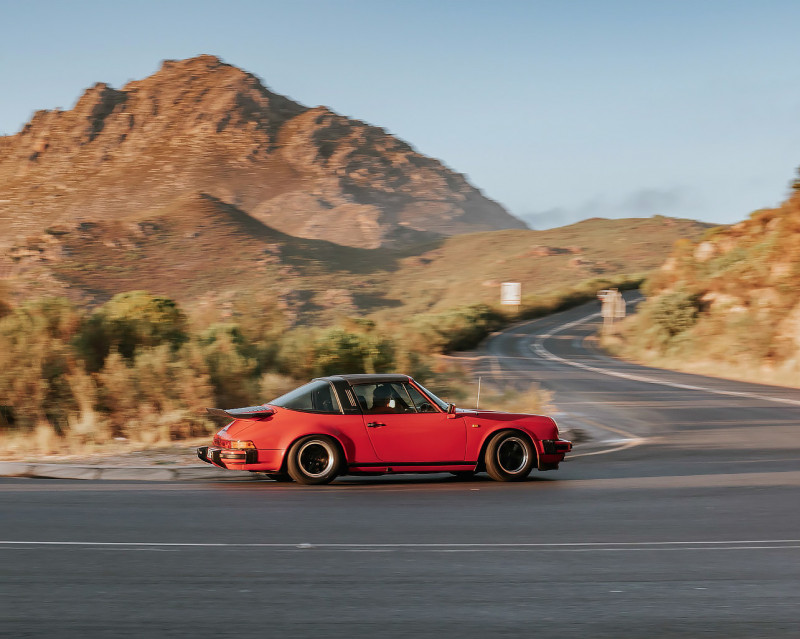
We decide to start the photography a little later and first enjoy the crisp morning air, the light traffic and stunning scenery. Sir Lowry’s Pass is a duallane, very fast road with long and sweeping bends. However, with average speed cameras you must keep to the speed limit, or stop at the top and appreciate the view. We decide to keep the removable top on for now. This allows for decent conversation in the cabin, although there’s some wind noise evident. Even with more than 107,000 miles on the odo, this gearbox still feels good. As long as you don’t rush changes, the gears slip with relative ease between each of the five speeds, although some gears are closer to one another in the horizontal shift action than others.
If you’re used to a 3.0-litre SC, there’s a clear increase in the level of performance here. You can cruise at low engine speeds of 2,000 to 3,000rpm, and with light throttle inputs there’s sufficient torque to accelerate in a spirited manner. Passing some large trucks and other mundane pick-ups – both are familiar sights on South Africa’s roads – the Targa feels compact and, as expected, low to the ground as you look up at these vehicles.
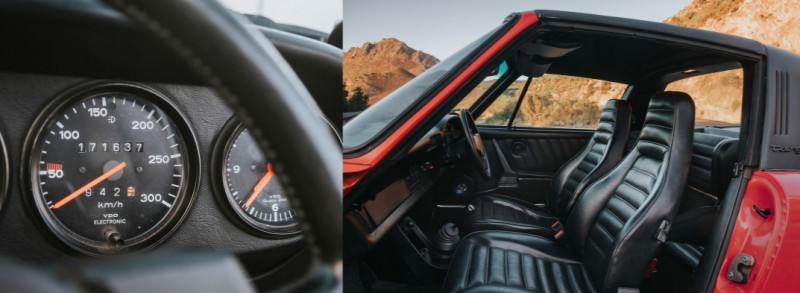
We cruise on and later head north off the main N2 highway to one of the narrow and twistier roads that leads into the Elgin Valley. As I drop a couple of gears and press the throttle pedal a little harder, the revs quickly increase. The rev needle climbs past 5,000 and 6,000rpm in a very linear and strong manner. There is, honestly, a very refreshingly level of performance! It’s during these delightful bursts of acceleration and also during braking that I’m reminded of the fact that the 3.2 Targa only tips the scales at a claimed 1,210 kg. It’s lightweight compared to today’s cars.
At the same time I also realise you don’t need to make use of the upper part of the rev range to move the car along at pace. However, when you do, the engine is very happy to oblige. The brakes feel strong and purposeful too, even at higher speeds. The clutch action does take some time to get used to, though. I have to learn to depress the clutch perfectly. It bites high up and I feel as though I need to anchor the bottom of my foot to the floor to release it without stalling the car. After a while I begin to feel more confident behind the wheel and enjoy every moment the free-revving engine sends the needle around the clock. When I start to push on, I realise there’s noticeable scuttle shake compared to that of a Coupe. I almost want to say you’re more aware of it, because in the Cabriolet the parts that indicate scuttle shake are further behind you and also stowed away. However, in the Targa the bar and sculpted rear window are right behind you, and that gives away some lower-level torsional rigidity.
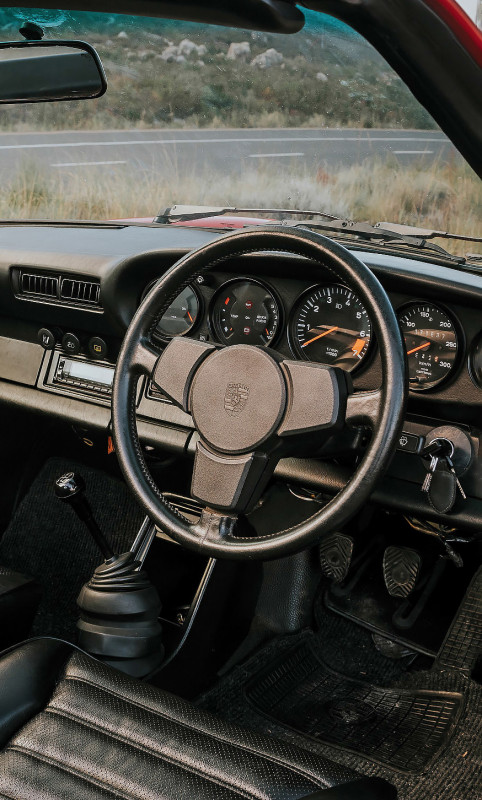
There are a number of ways the Targa makes up for it, though. We park next to one of the many dams in the area and quickly take the top down. First, you turn the clips above the driver and passenger area on the windscreen frame using a small tool. Then you lift the top out and fold it up. You can either store it behind the seats, or place it in the luggage compartment in the front where it’s safer, and its movement is also limited.
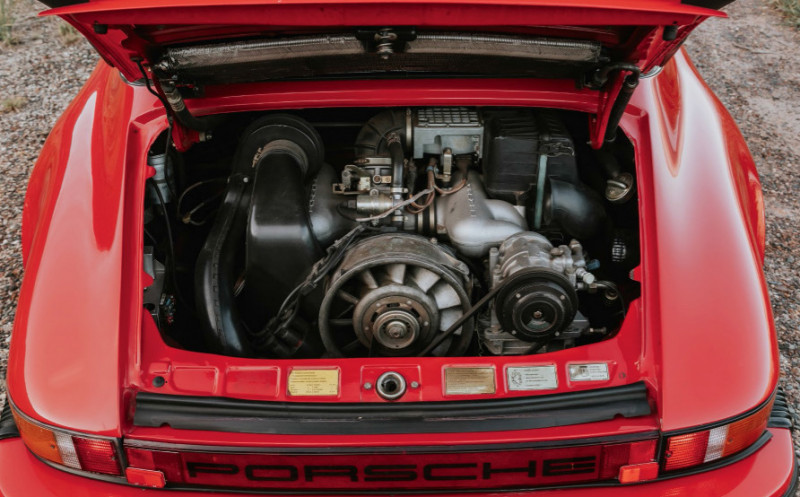
With the roof down and picking up speed past 60 and 70mph, the wind buffeting is reduced. There’s some wind noise of course, but the owner and I can still keep our conversation going while fresh air is blowing through the cabin. Travel at higher speeds though, and conversation starts to become more difficult.
This morning, talking is the last thing on my mind. It doesn’t bother me at all. The perfect temperature of the air is so welcoming after numerous, uncomfortably hot summer days here in South Africa. In a straight line, but especially when the road twists and turns, the steering wheel is communicative and I can sense precisely what the front axle is up to.
Fitted with the small (215/60 R15 in front and 195/65 R15 at the rear on this car) wheels and tyres combination, the Targa also rides well. Running on larger, lower-profile tyres will only have a detrimental effect on the drive experience. Turn in is as good as you’d expect, and there’s limited body roll, too. We stop at Houw Hoek Inn farmstall, a colloquial word meaning farm shop. These days the stalls cater for more than just travellers in search of quick sustenance. There’s usually an abundance of fresh produce, good coffee and a restaurant. The accompanying hotel lies just across the road, and it’s one of the oldest in South Africa. Although there’s yet another mountain pass called Houwhoek Pass to enjoy should you wish to travel further east, this breakfast stop is our turning-around spot. I look at the parking lot and, seeing all the SUVs, pick-ups and run-of-the-mill hatchbacks, I’m thankful that we have by far the most exciting car here for an early morning breakfast run.

The owner, Derick Coetzee, shares some thoughts about 911s and his Targa with me. “I’ve owned, bought and sold just over 10 911s over the years – and I’ve kept a few. I’ve had this particular Targa for the past eight years. Ideally, I would have liked to have a Coupe, a Targa and a Cabriolet, but I sadly sold a very neat G50 Cabriolet a few years ago. I do have a 1978 SC that I also use regularly. It’s an early car with wind-up windows. The few I now have, I rotate on a weekly basis.
“I found the Targa to have a little more headroom than a Coupe, although this matters little to me. My love for Porsche stems from my first car, which was an oval window, 1.1-litre, air-cooled Volkswagen Beetle. I was the second owner of that car.” Derick has several other 911 anecdotes of buying them in different parts of the country and driving through the night, and all the excitement that brings! After some smashed avocado on toast with egg, we leave the Targa top stowed in the front and head back to Somerset West where we both live. The sun is out and very soon I’m thankful I’ve packed my sunglasses. You can only hide so long behind the top of the windscreen frame before the sun shines straight in your eyes.
The air-conditioning system (or lack thereof!) might be insufficient for most hot countries, but with the wind blowing through the cabin and having caught the early morning hours, it matters little. Although the roads we chose for our drive are mostly wide and not even close to the narrow country lanes you can expect in the UK, the Targa’s narrow body and small footprint elevates the experience behind the wheel even further. The upright front lights indicate where the front corners are, while the rear axle isn’t much further behind us. The sloping of the front lid also means our view out in front is free from obstruction.
The fact that the steering wheel isn’t adjustable has never bothered me. The distance between the wheel and the gearlever is spot on, so all you have to do is move your seat forward or back. As UK owners will know, right-hand drive, air-cooled 911s have pedals offset to the left, but that seems to only bother you the moment you climb in. Once you’ve adjusted your legs, I found the seating position perfect – although I haven’t spent long hours behind the wheel. I stop at the top of Sir Lowry’s Pass, which is the highest point before we descend into the Helderberg area and head towards Cape Town. It gives a 180-degree view from the ocean all the way over the Cape Flats towards the more mountainous region of the Cape Winelands. The view is stunning, though I can’t help but glance back at the Guards red Targa as it basks in the summer sun.
Back in the car we head down this dual-lane pass with its fast, sweeping corners. As is the case with any lightweight car, little brake effort is needed to lower your speed. At the bottom we park and I hand back the key to the owner.
Many 911 enthusiasts might view the Targa as the least desirable of the classic body variants, but in the end it does offer a very likeable middle ground. It all depends on your plans for the car. But I can tell you this for certain: for an early breakfast run with friends, heading along some great roads without craving the ultimate in air-cooled performance, the 3.2 Targa is difficult to fault.
TECHNICAL DATA 1984 Porsche 911 Targa 3.2
- Year: 1984
Engine
- Engine capacity: 3,164cc
- Compression ratio: 9.5:1
- Maximum power: 204bhp at 5,900rpm
- Maximum torque: 264Nm at 4,800rpm
- Transmission: Five-speed manual
Suspension
- Front: Independent; McPherson struts; longitudinal torsion bars; anti-roll bar
- Rear: Independent; torsion bars; semi-trailing arms; anti-roll bar
Wheels & tyres
- Front: 6J x 15, 185/70 VR15 (standard)
- Rear: 7J x 15, 215/60 VR15 (standard)
Dimensions
- Length: 4,291mm
- Width: 1,652mm
- Weight: 1,210kg
Performance
- Acceleration 0-62mph: 6.5 seconds
- Top speed: 146mph
RIGHT While the steering wheel can’t be adjusted, the seat can be moved to help achieve the optimum driving position.
BELOW The Targa’s impact bumpers only serve to add to the car’s unique profile, although not all 911 enthusiasts are fans of them.
FAR LEFT Underneath the distinctive whaletale is a 3.2-litre flat six that’s capable of achieving 0-62mph in 6.5 seconds.
BELOW South Africa’s Western Cape in the early morning sunshine serves as a glorious backdrop for a drive in the Targa


